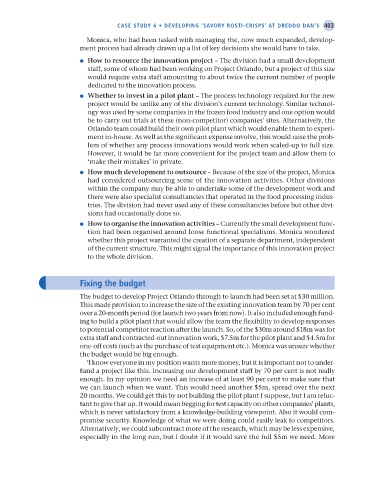Page 428 - Operations Strategy
P. 428
case stuDy 6 • Developing ‘savory rosti-crisps’ at DreDDo Dan’s 403
Monica, who had been tasked with managing the, now much expanded, develop-
ment process had already drawn up a list of key decisions she would have to take.
● How to resource the innovation project – The division had a small development
staff, some of whom had been working on Project Orlando, but a project of this size
would require extra staff amounting to about twice the current number of people
dedicated to the innovation process.
● Whether to invest in a pilot plant – The process technology required for the new
project would be unlike any of the division’s current technology. Similar technol-
ogy was used by some companies in the frozen food industry and one option would
be to carry out trials at these (non-competitor) companies’ sites. Alternatively, the
Orlando team could build their own pilot plant which would enable them to experi-
ment in-house. As well as the significant expense involve, this would raise the prob-
lem of whether any process innovations would work when scaled-up to full size.
However, it would be far more convenient for the project team and allow them to
‘make their mistakes’ in private.
● How much development to outsource – Because of the size of the project, Monica
had considered outsourcing some of the innovation activities. Other divisions
within the company may be able to undertake some of the development work and
there were also specialist consultancies that operated in the food processing indus-
tries. The division had never used any of these consultancies before but other divi-
sions had occasionally done so.
● How to organise the innovation activities – Currently the small development func-
tion had been organised around loose functional specialisms. Monica wondered
whether this project warranted the creation of a separate department, independent
of the current structure. This might signal the importance of this innovation project
to the whole division.
Fixing the budget
The budget to develop Project Orlando through to launch had been set at $30 million.
This made provision to increase the size of the existing innovation team by 70 per cent
over a 20-month period (for launch two years from now). It also included enough fund-
ing to build a pilot plant that would allow the team the flexibility to develop responses
to potential competitor reaction after the launch. So, of the $30m around $18m was for
extra staff and contracted-out innovation work, $7.5m for the pilot plant and $4.5m for
one-off costs (such as the purchase of test equipment etc.). Monica was unsure whether
the budget would be big enough.
‘I know everyone in my position wants more money, but it is important not to under-
fund a project like this. Increasing our development staff by 70 per cent is not really
enough. In my opinion we need an increase of at least 90 per cent to make sure that
we can launch when we want. This would need another $5m, spread over the next
20 months. We could get this by not building the pilot plant I suppose, but I am reluc-
tant to give that up. It would mean begging for test capacity on other companies’ plants,
which is never satisfactory from a knowledge-building viewpoint. Also it would com-
promise security. Knowledge of what we were doing could easily leak to competitors.
Alternatively, we could subcontract more of the research, which may be less expensive,
especially in the long run, but I doubt if it would save the full $5m we need. More
Z06 Operations Strategy 62492.indd 403 02/03/2017 13:44

